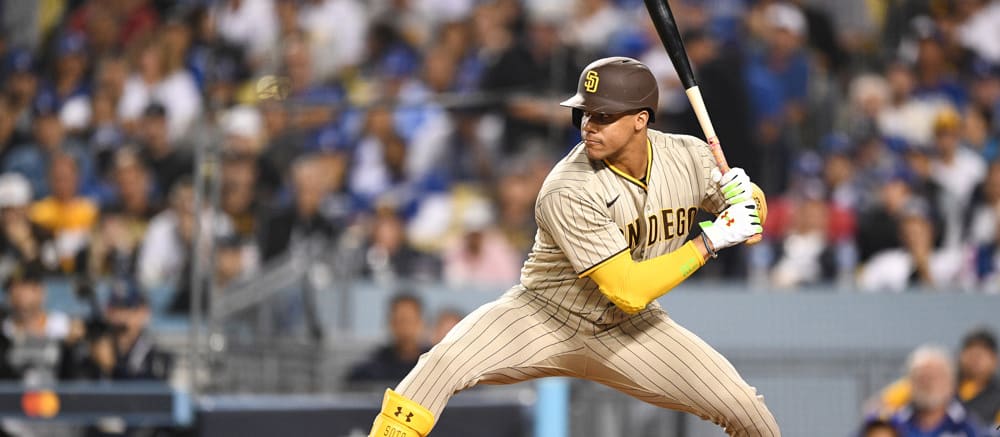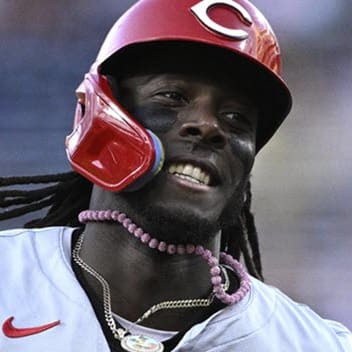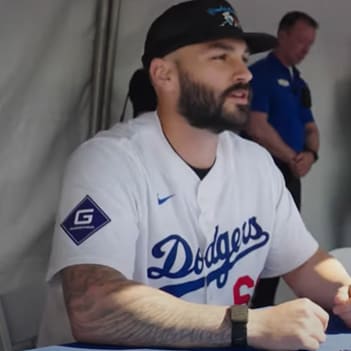One of the most popular contests that the National Fantasy Baseball Championship (NFBC) offers is the Draft Champions (DC) format. These 15-team, 50-round drafts debuted in 2011 with a draft-and-hold structure, meaning there are no in-season pickups. The inaugural contest had 390 overall entries and participation has grown significantly since then, with several thousand entering the most recent contests.
Draft Champions leagues are available at various entry fee levels: $150, $400, $1,000, $2,500 and $5,000. The majority of your entry fee goes to your individual league prizes, which pay out the top three finishers from each 15-team league.
League Entry Fee | 1st Place Prize | 2nd Place Prize | 3rd Place Prize |
|---|---|---|---|
$150 | $1,000 | $350 | $150 |
$400 | $3,000 | $1,100 | $400 |
$1,000 | $8,000 | $3,000 | $1,000 |
$2,500 | $20,000 | $7,500 | $5,000 |
$5,000 | $40,000 | $20,000 | $7,500 |
A portion of your entry fee is also reserved for the overall prizes that are awarded to the top finishing teams across the entire pool of Draft Champions leagues, regardless of entry fee. The overall prizes vary from year to year based on expected participation.
Rules
The NFBC Draft Champions contest uses rotisserie scoring based on the following categories:
Hitting Categories | Pitching Categories |
|---|---|
Runs (R) | Strikeouts (K) |
Home Runs (HR) | Wins (W) |
Runs Batted In (RBI) | Saves (SV) |
Stolen Bases (SB) | Earned Run Average (ERA) |
Batting Average (BA) | Walks and Hits per Inning Pitched (WHIP) |
You must actively set your lineup each week and are required to start 23 players — 14 hitters and 9 pitchers — from the 50
One of the most popular contests that the National Fantasy Baseball Championship (NFBC) offers is the Draft Champions (DC) format. These 15-team, 50-round drafts debuted in 2011 with a draft-and-hold structure, meaning there are no in-season pickups. The inaugural contest had 390 overall entries and participation has grown significantly since then, with several thousand entering the most recent contests.
Draft Champions leagues are available at various entry fee levels: $150, $400, $1,000, $2,500 and $5,000. The majority of your entry fee goes to your individual league prizes, which pay out the top three finishers from each 15-team league.
League Entry Fee | 1st Place Prize | 2nd Place Prize | 3rd Place Prize |
|---|---|---|---|
$150 | $1,000 | $350 | $150 |
$400 | $3,000 | $1,100 | $400 |
$1,000 | $8,000 | $3,000 | $1,000 |
$2,500 | $20,000 | $7,500 | $5,000 |
$5,000 | $40,000 | $20,000 | $7,500 |
A portion of your entry fee is also reserved for the overall prizes that are awarded to the top finishing teams across the entire pool of Draft Champions leagues, regardless of entry fee. The overall prizes vary from year to year based on expected participation.
Rules
The NFBC Draft Champions contest uses rotisserie scoring based on the following categories:
Hitting Categories | Pitching Categories |
|---|---|
Runs (R) | Strikeouts (K) |
Home Runs (HR) | Wins (W) |
Runs Batted In (RBI) | Saves (SV) |
Stolen Bases (SB) | Earned Run Average (ERA) |
Batting Average (BA) | Walks and Hits per Inning Pitched (WHIP) |
You must actively set your lineup each week and are required to start 23 players — 14 hitters and 9 pitchers — from the 50 players you drafted. Weekly lineup requirements are as follows:
- 2 Catchers
- 1 First Baseman
- 1 Second Baseman
- 1 Shortstop
- 1 Third Baseman
- 1 Middle Infielder (must qualify at either 2B or SS)
- 1 Corner Infielder (must qualify at either 1B or 3B)
- 5 Outfielders
- 1 Utility Player (any hitter)
- 9 Pitchers (can be starters or relief pitchers)
The remaining 27 players make up your bench. Drafting and rostering injured or minor-league players is allowed, but there are no injured list or minor-league spots, so make sure you're not taking on too much risk (i.e. players with an extensive injury history or prospects), especially since trades are not allowed in the NFBC.
Lineup Submission - Each player locks five minutes before their first scheduled game of the week, whether that game falls on a Monday or Tuesday. For example, if Juan Soto's first game of the week is on Tuesday at 7:05 pm ET, he will not lock for that week until Tuesday at 7:00 pm ET. This means you can freely move him in or out of your lineup until that lock time.
Always pay attention to your players' start times each week, especially when games are rescheduled due to inclement weather. Some teams may be scheduled to play early on a Monday afternoon, and if you forget to take players from those teams out of your lineup before the lock time, you will be stuck with their stats for that scoring period.
Weekly scoring periods in the NFBC are split up as follows:
- Monday through Thursday
- Friday through Sunday
The NFBC allows you to re-submit your hitting lineup every Friday for the weekend scoring period, but once your pitchers lock early in the week you cannot change them until the following Monday.
All NFBC Draft Champions leagues have a 950 innings pitched minimum for the ERA and WHIP categories. If a team does not meet this requirement at the conclusion of the season, it will be awarded one point in each category, but other teams in the league will not move up in the standings.
Joining a Draft Champions League
Draft Pace - The NFBC has several options to suit your preferred draft pace. Those who wish to complete their Draft Champions draft in one night should sign up for an "Express DC." There is a 55-second time limit for each pick and the draft continues until all 50 rounds are completed. These drafts typically last 4-to-4.5 hours from start to finish. That may seem like a long time, but these drafts are very fast-paced.
For those looking to join a draft with less pressure and more time between picks, the NFBC also offers "slow" DCs with either a 1-hour, 2-hour or 4-hour pick clock. These drafts typically last one-to-three weeks, depending on the pick clock you choose. If you sign up for a draft with a 2-hour or 4-hour pick clock, it's important to note that the timer is cut in half once the draft reaches Round 31. This is done in order to increase draft efficiency. For example, a 4-hour DC will have it's pick clock reduced to 2-hours once Round 31 begins. Similarly, a 2-hour DC will reduce it's pick clock to 1-hour at that same point of the draft. Slow DCs with a 1-hour pick clock do not have this caveat after Round 30. The pick clock remains 1-hour throughout the entire draft.
Since Draft Champions leagues may be comprised of players in various time zones, the draft clock pauses overnight from 1 a.m. Eastern Time until 9 a.m. Eastern Time. Picks can still be made when the draft clock is paused. If you are heading to bed before 1 a.m. Eastern Time and your pick is approaching, make sure you add players to your draft queue. Maintaining a full queue throughout your draft is encouraged, as is using NFBC's auto-draft feature when you are able.
KDS - This stands for Kentucky Derby System, which is a way to organize your preferred draft spots before the draft order is randomly determined by the NFBC. The default KDS setting when you sign up for a Draft Champions league is 1 through 15. You only have until shortly after the league fills up to edit your preferred KDS, so it's a good idea to adjust this on your league home page right after signing up.
For example, if you feel there is a group of six players who are clearly on top of the field for the upcoming season and would be comfortable with any of the six as your first-round pick, but you're not thrilled with the players being drafted in the middle of the first round, you may wish to set your KDS as follows:
6, 5, 4, 3, 2, 1, 15, 14, 13, 12, 11, 10, 9, 8, 7
When setting your KDS, it may be helpful to review Average Draft Position for the Draft Champions leagues that have already been completed. This will give you an idea of the players who will likely be available to you with your early-round picks. Mapping out the first few rounds of your draft can be a helpful exercise, but be prepared to have backup plans as the draft may not — and likely will not — play out as expected.
When it's time for the NFBC to run the draft order for your league, they will follow all 15 entrants' KDS preferences. Using the KDS example above, if you are randomly selected first by the NFBC, you would be awarded the sixth pick of the draft. The next random selection would get the top remaining pick from their KDS list, and so on.
All non-auction NFBC drafts follow a serpentine (or snake) format, meaning the draft order is reversed every round. The first-overall pick will pick 15th in the second round, then kick things off again in the third round. You may be familiar with Third Round Reversal, a system that's more commonly used in fantasy football drafts, but that method is not used for NFBC drafts.
Draft Preparation & Strategy
750 players are drafted in each Draft Champions league, so having a deep knowledge of the player pool is required to be successful. There comes a point in each draft where the talent dries up and you're left to draft players you're not excited about. Starting pitchers and hitters who are expected to receive regular at-bats become scarce at various points during the draft. You may not receive significant contributions from many of the players you draft after Round 35. However, the late rounds are still very important. Approach these rounds as you would the crucial middle rounds, as finding even one or two key contributors this late in your draft can be critical to your team's success, especially within the overall contest.
In the late game, many drafters emphasize a player's skills over their current role, figuring their talent will eventually afford them an opportunity to earn regular playing time. One success story from this approach was Spencer Strider during 2022 drafts. Despite his strikeout upside, Strider was widely available after Round 40 in 2022 Draft Champions leagues because his role with Atlanta was unclear. He initially appeared to be ticketed for Triple-A to open the season, and while he did break camp with the Braves, he spent some time as a reliever before eventually getting a shot in the starting rotation. Strider's dominant second half in 2022 rewarded the managers who drafted him for his skills that season. However, this is just one success story. There are countless others who don't play out as we might hope.
In fact, one should prioritize volume in the Draft Champions format above else. On the hitting side, the more plate appearances your players accrue over the course of the season, the more opportunities they have to accumulate runs, home runs, RBI and stolen bases. On the pitching side, having a few anchors in your starting rotation who will pitch 180-plus innings with excellent ratios is important.
You don't have to be an expert on prospects, but having an idea of which minor leaguers will be called up this coming season will be helpful when filling out your roster. Our Top 400 prospects list is a great starting point for this, as it includes each player's projected ETA. You can also look for players who were recently added to their team's 40-man roster, as it could be a sign that they're close to the majors.
Roster Construction - Since you're stuck with the 50 players you draft all season, it's important to have depth at each position to cover injuries, minor league demotions, or sudden change or loss of roles. It's not uncommon for Draft Champions teams to barely have enough healthy bodies to fill out their starting lineup in certain weeks.
As a general guideline, try to draft between 26-to-28 hitters and 22-to-24 pitchers. To have reasonable depth for your hitting lineup each week, shoot for the following:
- 3-to-4 catchers
- 6-to-8 corner infielders
- 6-to-8 middle infielders
- 10-to-11 outfielders
It is recommended that you come out of your draft with a minimum of 3-to-4 players that can cover each infield position. Targeting hitters with multi-position eligibility (MPE) can give you flexibility both during your draft and when setting your lineup, but don't put too much of an emphasis on these players. When deciding between two similar hitters, use MPE as a tie-breaker when the decision is close.
On the pitching side, it's important to have a plan for addressing the saves category. Some drafters like to pay up for a closer, while others like to wait and take more shots on potential save sources later in the draft. While having two elite closers is a luxury, you don't need two to be competitive in your league or the overall competition. However, having one secure closer may give you peace of mind throughout your draft and during the season. Recent Draft Champions trends indicate the truly elite closers are generally off the board within the first few rounds. If you're not comfortable with drafting or researching late-round save sources, plan on targeting a top-10 closer within the first seven or eight rounds.
While there's no rule that states how many closers or relief pitchers must be started relative to starting pitchers, a general guideline to follow each week is:
- 6 starting pitchers
- 2 save sources
- 1 flex (can be a starter or reliever)
Since volume is important, a fringe starter with a two good pitching matchups in the coming week could fill that last spot. Or you could elect to start an elite reliever (non-closer) with strikeout or ratio upside.
Punting Categories - Punting a category, such as saves or stolen bases, is not advisable in Draft Champions leagues, as it immediately eliminates you from overall prize contention. You may still be able to win or cash in your individual league, but try to keep the overall competition in mind, as that's where the big prizes are.
Category Targets - Having balance across all five hitting and pitching categories will go a long way towards achieving Draft Champions success. Many drafters use the 80th percentile statistics from the prior season's overall standings as category targets for the coming year. As the new season gets under way, track those same 80th percentile statistics for the current overall standings each week to see which categories you are falling behind in. This exercise will better inform your lineup decisions each week. While it's not guaranteed, you stand a much greater chance of winning your league if you are near the 80th percentile across all 10 categories. If you're coming in even higher than that across the board, your chances increase of winning an overall prize increase.
In-Season Management
Most of the heavy lifting in Draft Champions leagues is done before and during the draft. Since there are no trades or in-season pickups, the only in-season management required is setting your lineup.










